Related Research Articles

In computing, load balancing is the process of distributing a set of tasks over a set of resources, with the aim of making their overall processing more efficient. Load balancing can optimize the response time and avoid unevenly overloading some compute nodes while other compute nodes are left idle.

A power outage is the loss of the electrical power network supply to an end user.

A cascading failure is a failure in a system of interconnected parts in which the failure of one or few parts leads to the failure of other parts, growing progressively as a result of positive feedback. This can occur when a single part fails, increasing the probability that other portions of the system fail. Such a failure may happen in many types of systems, including power transmission, computer networking, finance, transportation systems, organisms, the human body, and ecosystems.

In materials science, fatigue is the initiation and propagation of cracks in a material due to cyclic loading. Once a fatigue crack has initiated, it grows a small amount with each loading cycle, typically producing striations on some parts of the fracture surface. The crack will continue to grow until it reaches a critical size, which occurs when the stress intensity factor of the crack exceeds the fracture toughness of the material, producing rapid propagation and typically complete fracture of the structure.
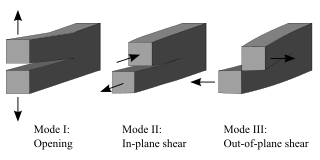
Fracture mechanics is the field of mechanics concerned with the study of the propagation of cracks in materials. It uses methods of analytical solid mechanics to calculate the driving force on a crack and those of experimental solid mechanics to characterize the material's resistance to fracture.
In software architecture, publish–subscribe is a messaging pattern where publishers categorize messages into classes that are received by subscribers. This is contrasted to the typical messaging pattern model where publishers sends messages directly to subscribers.
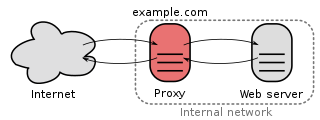
In computer networks, a reverse proxy is an application that sits in front of back-end applications and forwards client requests to those applications. Reverse proxies help increase scalability, performance, resilience and security. The resources returned to the client appear as if they originated from the web server itself.
A glowing plate in a vacuum tube circuit indicates that the tube is drawing excessive current. This causes the anode ("plate") to overheat and radiate a visible red or orange glow. In consumer electronics, this is universally indicative that the tube is experiencing an overload condition, though the reasons for the overload may vary.
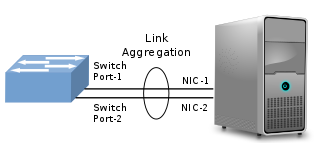
In computer networking, link aggregation is the combining of multiple network connections in parallel by any of several methods. Link aggregation increases total throughput beyond what a single connection could sustain, and provides redundancy where all but one of the physical links may fail without losing connectivity. A link aggregation group (LAG) is the combined collection of physical ports.
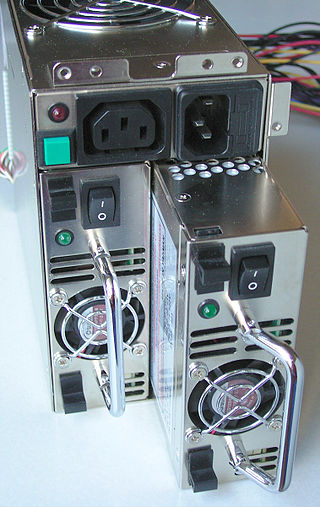
In engineering, redundancy is the intentional duplication of critical components or functions of a system with the goal of increasing reliability of the system, usually in the form of a backup or fail-safe, or to improve actual system performance, such as in the case of GNSS receivers, or multi-threaded computer processing.
Fault tolerance is the property that enables a system to continue operating properly in the event of the failure of one or more faults within some of its components. If its operating quality decreases at all, the decrease is proportional to the severity of the failure, as compared to a naively designed system, in which even a small failure can cause total breakdown. Fault tolerance is particularly sought after in high-availability, mission-critical, or even life-critical systems. The ability of maintaining functionality when portions of a system break down is referred to as graceful degradation.
A cybersecurity regulation comprises directives that safeguard information technology and computer systems with the purpose of forcing companies and organizations to protect their systems and information from cyberattacks like viruses, worms, Trojan horses, phishing, denial of service (DOS) attacks, unauthorized access and control system attacks. There are numerous measures available to prevent cyberattacks.
High availability (HA) is a characteristic of a system that aims to ensure an agreed level of operational performance, usually uptime, for a higher than normal period.

A hard disk drive failure occurs when a hard disk drive malfunctions and the stored information cannot be accessed with a properly configured computer.

Failure is the social concept of not meeting a desirable or intended objective, and is usually viewed as the opposite of success. The criteria for failure depends on context, and may be relative to a particular observer or belief system. One person might consider a failure what another person considers a success, particularly in cases of direct competition or a zero-sum game. Similarly, the degree of success or failure in a situation may be differently viewed by distinct observers or participants, such that a situation that one considers to be a failure, another might consider to be a success, a qualified success or a neutral situation.

A single point of failure (SPOF) is a part of a system that, if it fails, will stop the entire system from working. SPOFs are undesirable in any system with a goal of high availability or reliability, be it a business practice, software application, or other industrial system.
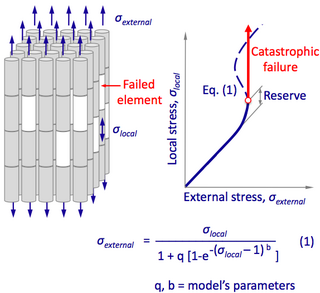
Structural fracture mechanics is the field of structural engineering concerned with the study of load-carrying structures that includes one or several failed or damaged components. It uses methods of analytical solid mechanics, structural engineering, safety engineering, probability theory, and catastrophe theory to calculate the load and stress in the structural components and analyze the safety of a damaged structure.

Structural integrity and failure is an aspect of engineering that deals with the ability of a structure to support a designed structural load without breaking and includes the study of past structural failures in order to prevent failures in future designs.

Engineering disasters often arise from shortcuts in the design process. Engineering is the science and technology used to meet the needs and demands of society. These demands include buildings, aircraft, vessels, and computer software. In order to meet society’s demands, the creation of newer technology and infrastructure must be met efficiently and cost-effectively. To accomplish this, managers and engineers need a mutual approach to the specified demand at hand. This can lead to shortcuts in engineering design to reduce costs of construction and fabrication. Occasionally, these shortcuts can lead to unexpected design failures.
Application Defined Network (ADN) is an enterprise data network that uses virtual networks and security components to provide a dedicated logical network for each application. This allows customized security and network policies to be created to meet the requirements of that specific application. ADN technology allows for a simple physical architecture with fewer devices, less device configuration and integration. ADN solutions simplify businesses' need to securely deploy multiple applications across the enterprise footprint and partner networks, regardless of where the application resides. ADN platforms provide policy-based, application-specific delivery to corporate data centers, cloud services and third-party networks securely and cost-effectively. Some ADN solutions integrate 3G/4G wireless backup services to enable a second internet connection automatically and instantly when connectivity is lost on the primary access connection. The ADN design provides an application-to-application (A2A) based model that evolves enterprise networks beyond the site-to-site (S2S) private model.
References
- 1 2 Homeland Insecurity Archived 2011-09-28 at the Wayback Machine , Atlantic Monthly , September 2002
- ↑ David Hillson (29 March 2011). The Failure Files: Perspectives on Failure. Triarchy Press. p. 146. ISBN 9781908009302.
- 1 2 Eric Vanderburg (February 18, 2013). "Fail Secure – The right way to fail". PC Security World.
- ↑ Failing Well with Information Security Archived 2008-10-14 at the Wayback Machine - Young, William; Apogee Ltd Consulting, 2003